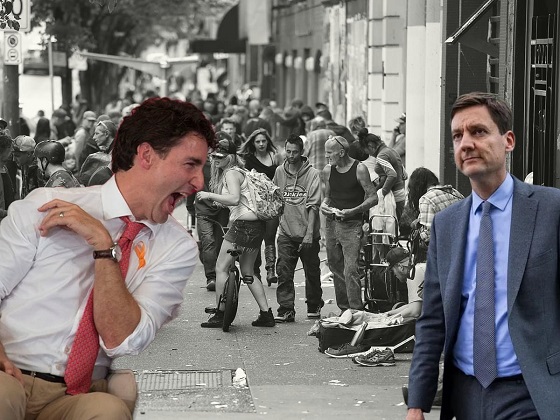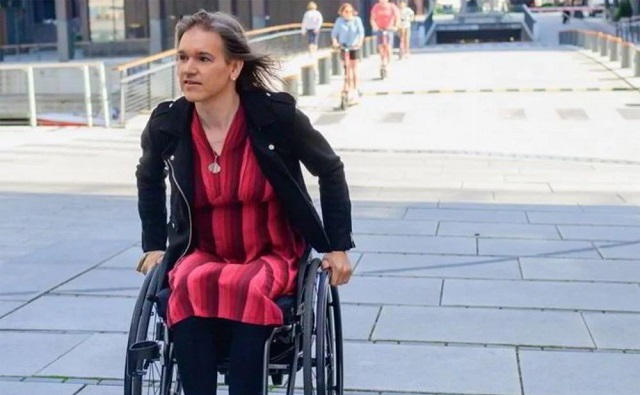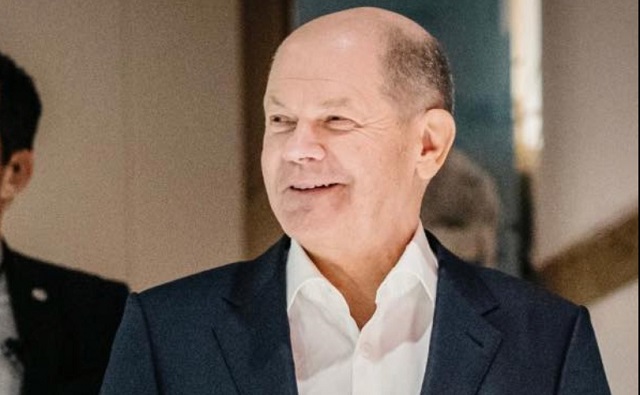Opinion
Politicized Language: A harmless evolution of language or a step towards “1984″?

Good chance you’ve noticed some new words lately, or new meanings for words that used to mean something else. Terms like “birthing person” are new, and words like “racism” seem to be taking on a new meaning. 19 time Emmy Award Winning Journalist John Stossel is back with his take on “Politicized Language”
From StosselTV
“Social justice” activists are changing and redefining many words, from “birthing people”, “equity”, “mistress”, “violence”, to “racism”.
Is that a harmless evolution of language? Or a step towards “1984?”
Tim Sandefur of the Goldwater Institute argues that today’s language changes are dangerous. For example, one activist declared that “a transgender woman of color walking down the street and being called a man — [that] is an act of violence.” “It is quite chilling,” says Sandefur, the degree to which the social justice movement… is willing to control our language.”
“The only way that we have as human beings to deal with one another is through language, discussion, debate, deliberation. If we say that that’s a form of violence … then the only way left for us to relate to one another is through power,” he adds. I push back , saying that the social justice movement has good intentions.
—- So you don’t miss the weekly video from Stossel TV, sign up here: https://johnstossel.activehosted.com/f/1 —-
Alberta
Coutts Three verdict: A warning to protestors who act as liaison with police

From the Frontier Centre for Public Policy
By Ray McGinnis
During the trial numbers of RCMP officers conceded that the Coutts Three were helpful in their interactions with the law. As well, there didn’t seem to be any truth to the suggestion that Van Huigenbos, Van Herk and Janzen were leaders of the protest.
Twelve jurors have found the Coutts Three guilty of mischief over $5,000 at a courthouse in Lethbridge, Alberta. Marco Van Huigenbois, Alex Van Herk and George Janzen will appear again in court on July 22 for sentencing.
Van Huigenbois, Van Herk and Janzen were each protesting at the Coutts Blockade in 2022. A blockade of Alberta Highway 4 began on January 29, 2022, blocking traffic, on and off, on Alberta Highway 4 near the Coutts-Sweetgrass Canada-USA border crossing. The protests were in support of the Freedom Convoy protests in Ottawa.
Protests began due to the vaccine mandates for truckers entering Canada, and lockdowns that bankrupted 120,000 small businesses. Government edicts were purportedly for “public health” to stop the spread of the C-19 virus. Yet the CDC’s Dr. Rachel Wallensky admitted on CNN in August 2021 the vaccine did not prevent infection or stop transmission.
By February 2022, a US court forced Pfizer to release its “Cumulative Analysis of Post-Authorization Adverse Event Reports” revealing the company knew by the end of February, 2021, that 1,223 people had a “case outcome” of “fatal” as a result of taking the companies’ vaccine.
On the day of February 14, 2022, the three men spoke to Coutts protesters after a cache of weapons had been displayed by the RCMP. These were in connection with the arrest of the Coutts Four. Van Huigenbos and others persuaded the protesters to leave Coutts, which they did by February 15, 2022.
During the trial numbers of RCMP officers conceded that the Coutts Three were helpful in their interactions with the law. As well, there didn’t seem to be any truth to the suggestion that Van Huigenbos, Van Herk and Janzen were leaders of the protest.
RCMP officer Greg Tulloch testified that there were a number of “factions” within the larger protest group. These factions had strong disagreements about how to proceed with the protest. The Crown contended the Coutts Three were the leaders of the protest.
During his testimony, Tulloch recalled how Van Huigenbos and Janzen assisted him in getting past the “vehicle blockade to enter Coutts at a time during the protest when access to Coutts from the north via the AB-4 highway was blocked.” Tulloch also testified that Janzen and Van Huigenbos helped with handling RCMP negotiations with the protesters. Tulloch gave credit to these two “being able to help move vehicles at times to open lanes on the AB-4 highway to facilitate the flow of traffic in both directions.”
During cross examination by George Janzen’s lawyer, Alan Honner, Tulloch stated that he noticed two of the defendants assisting RCMP with reopening the highway in both directions. Honner said in summary, “[Marco Van Huigenbos and George Janzen] didn’t close the road, they opened it.”
Mark Wielgosz, an RCMP officer for over twenty years, worked as a liaison between law enforcement and protesters at the Coutts blockade. Taking the stand, he concurred that there was sharp disagreement among the Coutts protesters and the path forward with their demonstration. Rebel News video clips “submitted by both the Crown and defence teams captured these disagreements as demonstrators congregated in the Smuggler’s Saloon, a location where many of the protesters met to discuss and debate their demonstration.” Wielgosz made several attempts to name the leaders of the protest in his role as a RCMP liaison with the protesters, but was unsuccessful.”
However, the Crown maintained that the protest unlawfully obstructed people’s access to property on Highway 4.
Canada’s Criminal Code defines mischief as follows in Section 430:
Every one commits mischief who willfully
(a) destroys or damages property;
(b) renders property dangerous, useless, inoperative or ineffective;
(c) obstructs, interrupts or interferes with the lawful use, enjoyment or operation of property; or
(d) obstructs, interrupts or interferes with any person in the lawful use, enjoyment or operation of property.
Robert Kraychik reported that “RCMP Superintendent Gordon Corbett…cried (no comment on the sincerity of this emoting) while testifying about a female RCMP officer that was startled by the movement of a tractor with a large blade during the Coutts blockade/protest.” This was the climax of the trial. A tractor moving some distance away from an officer in rural Alberta, with blades. The shock of it all.
No evidence was presented in the trial that Van Huigenbos, Van Herk and Janzen destroyed or damaged property. Officers testified they couldn’t identify who the protest leaders were. They testified the defendants assisted with opening traffic lanes, and winding down the protest.
By volunteering to liaise with the RCMP, the Crown depicted the Coutts Three as the protest leaders. Who will choose to volunteer at any future peaceful, non-violent, protest to act as a liaison with the policing authorities? Knowing of the verdict handed down on April 16, 2024, in Lethbridge?
Ray McGinnis is a Senior Fellow with the Frontier Centre for Public Policy. His forthcoming book is Unjustified: The Emergencies Act and the Inquiry that Got It Wrong.
Opinion
Fentanyl Fiasco: The Tragic Missteps of BC’s Drug Policy

From The Opposition News Network
|
|
Unmasking the Destructive Cycle of Drug Policy in British Columbia. A Tale of Good Intentions and Dire Consequences
My fellow Canadians, it’s been a challenging time. I had initially planned to bring you the latest spectacle from the House of Commons, featuring Kristian Firth, but fate had other plans. A personal emergency struck closer to home—a fentanyl overdose in the family. This tragic event threw us headlong into the chaotic circus that is the British Columbia health system. Let me be frank: the system is a mockery. The privacy laws that supposedly protect us also shroud our crises in unnecessary mystery. When my uncle was found unconscious and rushed to the ICU, the walls of confidentiality meant we could not even ascertain his condition over the phone. They notify you of the disaster but cloak its nature in secrecy. It’s an absurdity that only adds to the anguish of families grappling with the realities of addiction.
Now, let’s address the elephant in the room: our approach to drug addiction. The authorities label it a disease, yet paradoxically offer the afflicted the choice between seeking help and remaining in their dire state. This half-hearted stance on drug addiction only perpetuates a cycle of relapse and despair. As we speak, thousands tumble through the revolving doors of our medical facilities—5,975 apparent opioid toxicity deaths this year alone, an 8% increase from 2022. Daily, we see 22 deaths and 17 hospitalizations, and yet our response remains as ineffective as ever. This issue transcends our national borders. The U.S. has openly criticized China for its role in the opioid crisis, accusing it of flooding North America with fentanyl—a drug so potent, it’s decimating communities at an unprecedented rate. Just last year, over 70,000 Americans succumbed to fentanyl overdoses. And what’s more damning? Reports from U.S. congressional committees suggest that the Chinese government might be subsidizing firms that traffic these lethal substances. Lets be clear this is a state-sponsored assault on our populace.
In response to this crisis BC NDP policymakers have championed the notion of “safe supply” programs. These initiatives distribute free hydromorphone, a potent opioid akin to heroin, with the intention of steering users away from the perils of contaminated street drugs. At first glance, this approach might seem logical, even humane. However, the grim realities paint a far different picture, one where good intentions pave the road to societal decay. Addiction specialists are sounding the alarm, and the news isn’t good. While hydromorphone is potent, it lacks the intensity to satisfy fentanyl users, leading to an unintended consequence: diversion. Users, unappeased by the drug’s effects, are selling their “safe” supply on the black market. This results in a glut of hydromorphone flooding the streets, crashing its price by up to 95% in certain areas. This collapse in street value might seem like a win for economic textbooks, but in the harsh world of drug abuse, it’s a catalyst for disaster. Cheap, readily available opioids are finding their way into the hands of an ever-younger audience, ensnaring teenagers in the grips of addiction. Far from reducing harm, these programs are inadvertently setting the stage for a new wave of drug dependency among our most vulnerable.
Programs designed to save lives are instead spinning a web of addiction that ensnares not just existing drug users but also initiates unsuspecting adolescents into a life of dependency. What’s needed isn’t more drugs, even under the guise of medical oversight, but a robust support system that addresses the root causes of addiction yet, the stark reality on the streets tells a story of systemic failure. Let’s dissect the current approach to handling addiction, a condition deeply intertwined with our societal, legal, and health systems.
Take a typical scenario—an individual battling the throes of addiction. Many of them find themselves ensnared by the law, often for crimes like theft, driven by the desperate need to sustain their habit. Yes, many addicts find themselves behind bars, where, paradoxically, they claim to clean up. Jail, devoid of freedom, ironically becomes a place of forced sobriety.
Now, consider the next step in this cycle: release. Upon their release, these individuals, now momentarily clean, are promised treatment—real help, real change. Yet, here’s the catch: this promised help is dangled like a carrot on a stick, often 30 or more days away. What happens in those 30 days? Left to their own devices, many relapse, falling back into old patterns before they ever step foot in a treatment facility.
This brings us to a critical question: why release an individual who has begun to detox in a controlled environment, only to thrust them back into the very conditions that fueled their addiction? Why not maintain custody until a treatment spot opens up? From a fiscal perspective, this dance of incarceration, release, and delayed treatment is an exercise in futility, burning through public funds without solving the core issue. Moreover, from a standpoint of basic human decency and dignity, this system is profoundly flawed. We play roulette with lives on the line, hoping against odds for a favorable outcome when we already hold a losing hand. This isn’t just ineffective; it’s cruel.
Final Thoughts
As we close the curtain on this discussion, let’s not mince words. The BC system’s approach to drug addiction treatment isn’t just flawed; it’s a catastrophic failure masquerading as mercy. Opposition leader Pierre Poilievre has hit the nail squarely on the head in his piece for the National Post. He articulates a vision where compassion and practicality intersect, not through the failed policies of perpetual maintenance, but through genuine, recovery-oriented solutions. His stance is clear: treat addiction as the profound health crisis it is, not as a criminal issue to be swept under the rug of incarceration.
Contrast this with the so-called ‘safe supply’ madness—a Band-Aid solution to a hemorrhaging societal wound. In the dystopian theatre of the Downtown Eastside, where welfare checks and drug dens operate with the efficiency of a grotesque assembly line, what we see is not healthcare, but a deathcare system. It’s a cycle of despair that offers a needle in one hand and a shot of naloxone in the other as a safety net. This isn’t treatment; it’s a perverse form of life support that keeps the heart beating but lets the soul wither.
Come next election in BC, if any provincial party is prepared to advocate for a true treatment-first approach, to shift from enabling addiction to empowering recovery, they will have my—and should have your—unwavering support. We must champion platforms that prioritize recovery, that respect human dignity, and that restore hope to the heartbroken streets of our communities.
The NDP BC government’s current model perpetuates death and decay under the guise of progressive policy. It’s a cruel joke on the citizens who need help the most. We can no longer afford to stand idly by as lives are lost to a system that confuses sustaining addiction with saving lives. Let’s rally for change, for recovery, for a future where Canadians struggling with addiction are given a real shot at redemption. This isn’t just a political imperative—it’s a moral one. The time for half-measures is over. The time for real action is now.
Become a supporter of The Opposition with Dan Knight .
For the full experience, click here to upgrade your subscription.
-

 Opinion1 day ago
Opinion1 day agoTransgender ideology has enabled people to ‘identify’ as amputees
-

 International1 day ago
International1 day agoGerman parliament passes law allowing minors to change their legal gender once a year
-

 International2 days ago
International2 days agoTelegram founder tells Tucker Carlson that US intel agents tried to spy on user messages
-

 Business1 day ago
Business1 day agoCanada’s economy has stagnated despite Ottawa’s spin
-

 Alberta18 hours ago
Alberta18 hours agoCanada’s advantage as the world’s demand for plastic continues to grow
-

 Business2 days ago
Business2 days agoNew capital gains hike won’t work as claimed but will harm the economy
-

 Economy2 days ago
Economy2 days agoExtreme Weather and Climate Change
-

 Fraser Institute1 day ago
Fraser Institute1 day agoPowerful players count on corruption of ideal carbon tax







